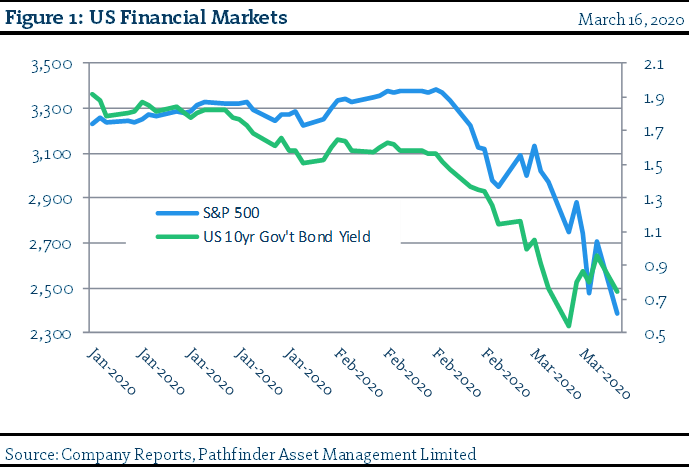The End of a Bull Market
Over the past few weeks, we have been studying and writing about geopolitical events because they have been taking headlines in the regular and financial press since the start of the year. We have one more note in this series that we will release in the coming weeks, but I thought for this issue, we would again discuss financial markets give the significant and swift change.
A bear market is defined as a drop of 20% from a market high, while a correction is half of that (i.e. 10%). Today North American markets have fallen past 30% from the high, after a very strong close on Friday. We noted some data today from CIBC which presented the number of days that it has taken for markets to turn into “bears”. On average, it takes 149 days of up and down volatility from the peak before a bear market is reached. For the 2008 Great Financial Crisis, it took 184 days, and for COVID-19 it took only 19 days.
- We present equity and fixed income market performance again, this time for the year-to-date, in Figure 1 to the right, so you can see how quickly the markets changed.

- We believe that the quick shift in the market over the past three weeks represents the emotional reaction (fear) from the point when North American Investors realized that COVID19 would not be contained in Asia.
- We have written in this note that we believed valuations were stretched into the end of 2019. We also believe that the first part of the market decline was a valuation reset of what we believe were already too high prices. As we enter, again what we believe will be, a traditional demand/supply recession, the market will try to determine the impact of a slowing global economy. This will take some time because the government reaction to COVID-19 is uncertain.
“This means that” while we continue to remain concerned about the human cost of COVID-19 and now believe that we are in a global recession, we also remain focused on our investment process. This past weekend, we have reset our valuation ranges and will begin to take new positions in companies as opportunities present. I would like to reiterate that it is important to maintain a long-term perspective. Being prepared and level-headed will hopefully allow us to position our portfolios with excellent quality companies over the coming months. This will serve us well in the future.
National Instrument 31-103 requires registered firms to disclose information that a reasonable investor would expect to know, including any material conflicts with the firm or its representatives. Doug Johnson and/or Pathfinder Asset Management Limited are an insider of companies periodically mentioned in this report. Please visit www.paml.ca for full disclosures.
*All returns are time weighted and net of investment management fees. Returns from the Pathfinder Partners’ Fund and Pathfinder Real Fund are presented based on the masters series of each fund. The Pathfinder North American Equity Portfolio and The Pathfinder North American Income Portfolio are live accounts. These are actual accounts owned by the Pathfinder Chairman (Equity) and client (High Income) which contain no legacy positions, cash flows or other Pathfinder investment mandates or products. Monthly inception dates for each fund and portfolio are as follows: Pathfinder North American Equity Portfolio (January 2011), Pathfinder North American High-Income Portfolio (October 2012) Pathfinder Partners’ Fund (April 2011), Pathfinder Real Fund (April, 2013), and Pathfinder International Fund (November 2014).
Pathfinder Asset Management Limited (PAML) and its affiliates may collectively beneficially own in excess of 10% of one or more classes of the issued and outstanding equity securities mentioned in this newsletter. This publication is intended only to convey information. It is not to be construed as an investment guide or as an offer or solicitation of an offer to buy or sell any of the securities mentioned in it. The author has taken all usual and reasonable precautions to determine that the information contained in this publication has been obtained from sources believed to be reliable and that the procedures used to summarize and analyze such information are based on approved practices and principles in the investment industry. However, the market forces underlying investment value are subject to sudden and dramatic changes and data availability varies from one moment to the next. Consequently, neither the author nor PAML can make any warranty as to the accuracy or completeness of information, analysis or views contained in this publication or their usefulness or suitability in any particular circumstance. You should not undertake any investment or portfolio assessment or other transaction on the basis of this publication, but should first consult your portfolio manager, who can assess all relevant particulars of any proposed investment or transaction. PAML and the author accept no liability of any kind whatsoever or any damages or losses incurred by you as a result of reliance upon or use of this publication.